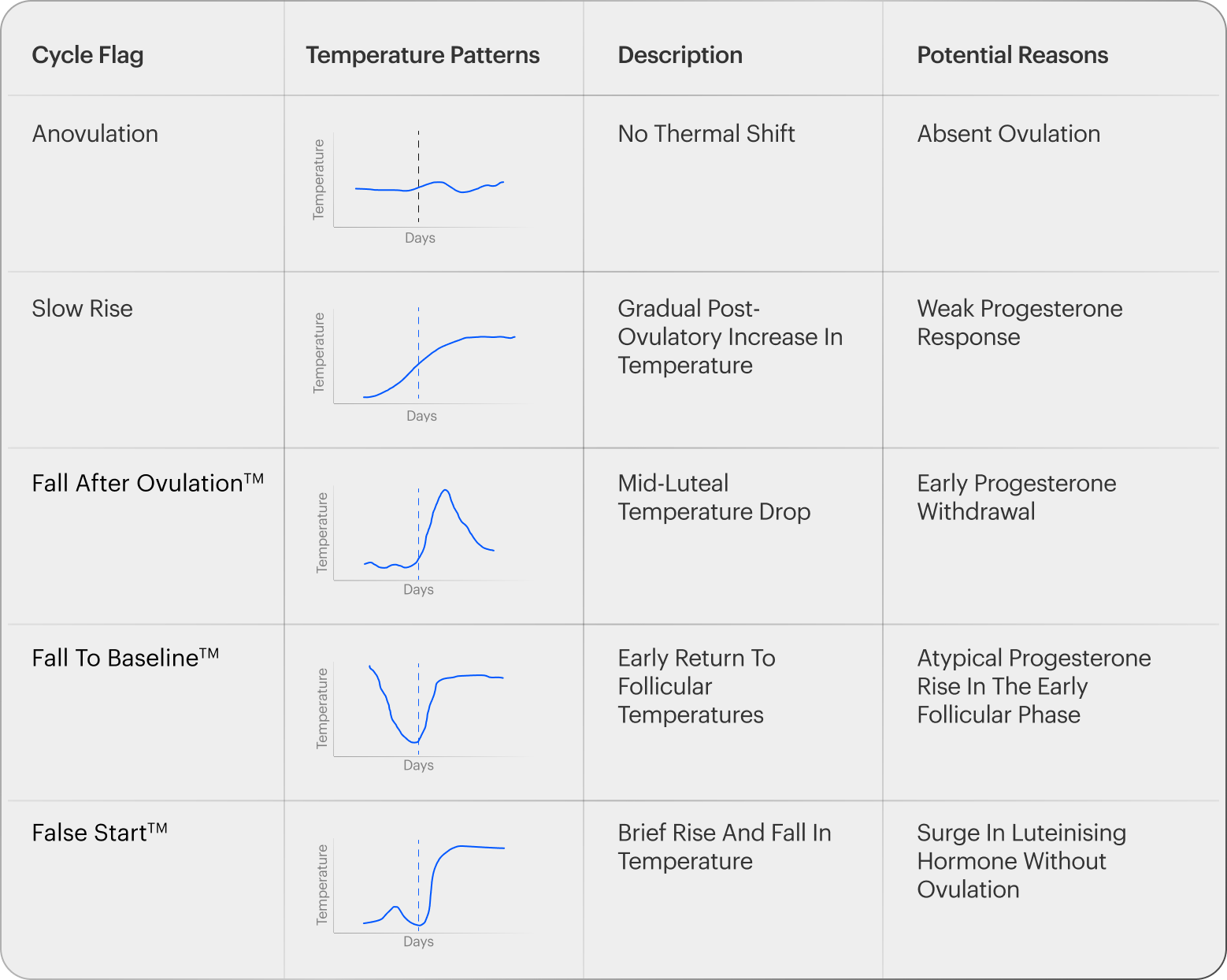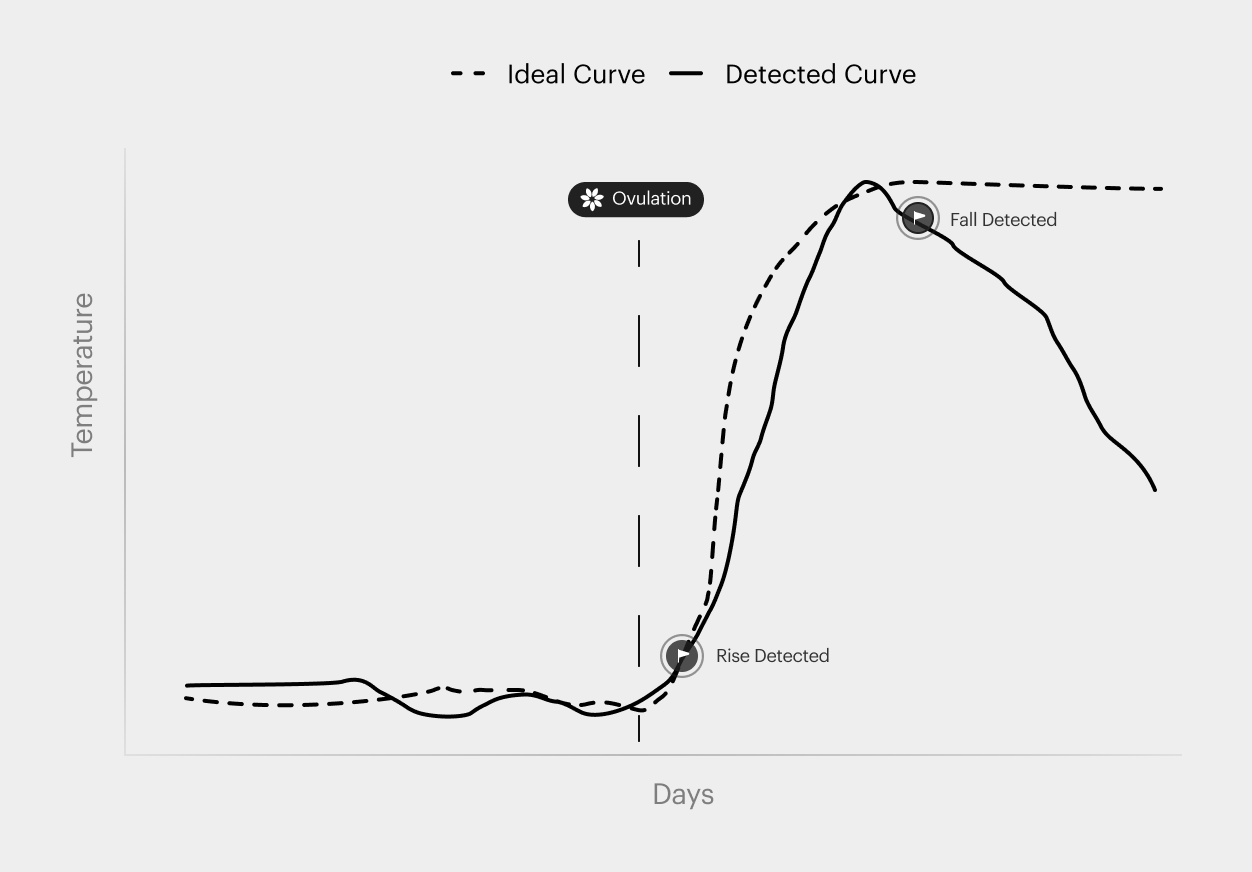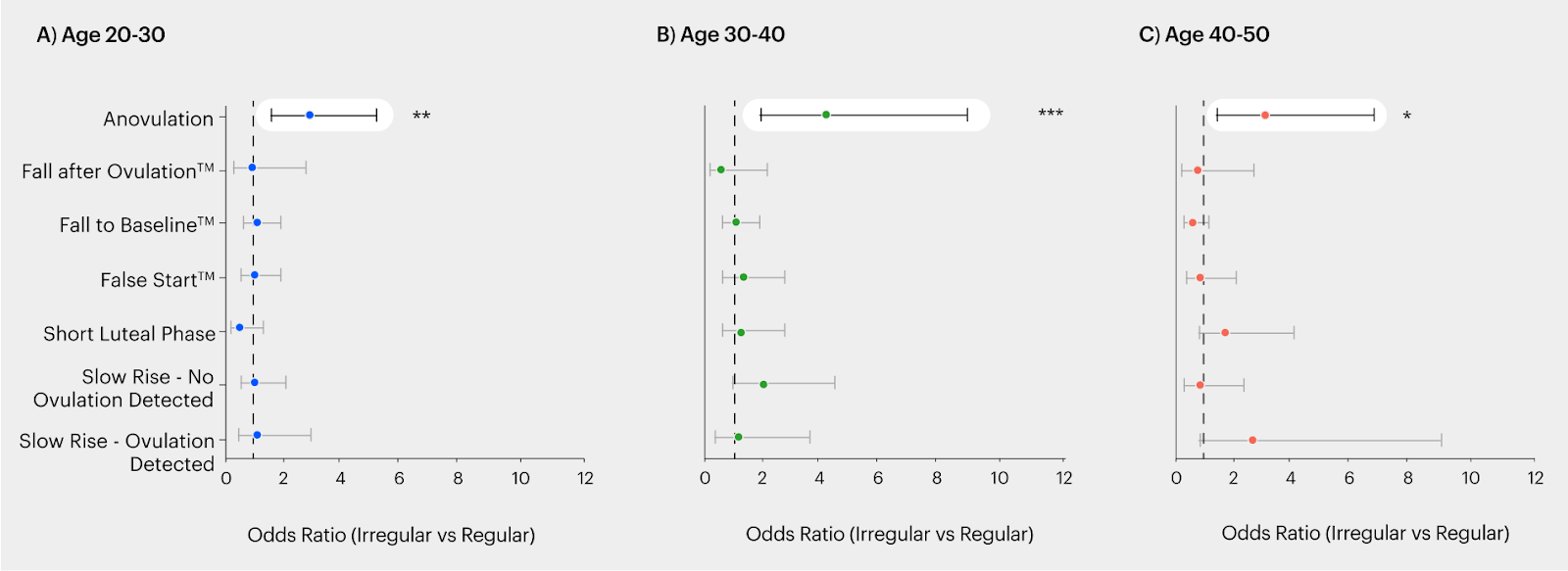a Ultrahuman Healthcare Pvt. Ltd., India
b viO HealthTech Ltd., United Kingdom
Objective: To examine how temperature-derived Cycle FlagsTM by the OvuSenseTM algorithm align with health conditions in Ultrahuman Ring AIR female users.
Data: Skin temperature data from 1,297 cycles of 1,163 women (ages 20–50), including regular/irregular cycles and self-reported PCOS and endometriosis.
Findings:
Conclusion: Cycle FlagsTM reveal age- and condition-specific temperature signatures, advancing passive, real-time menstrual health tracking.
Cyclical changes in body temperature have proven to be sensitive markers of menstrual health, rising typically by 0.3-0.5°C after ovulation due to increased progesterone. While this pattern is consistent at the population level, individual variability in ovulatory timing, luteal length, and temperature shifts has been found to be high, even in regular cycles.1, 2 Women with conditions like polycystic ovarian syndrome (PCOS), endometriosis, or those undergoing menopausal transition (MT, or perimenopause), such variability is often greater, making ovulation tracking more challenging. While continuous skin temperature monitoring via wearable sensors offers a non-invasive way to observe these changes3, subtle yet informative temperature gradient patterns often remain under-utilized. These thermal signatures carry information that can enrich the awareness that a woman can derive from wearables for improved health optimization.4
The OvuSenseTM algorithm was derived from numerous years of research and trained on a dataset derived from 250,000+ menstrual cycles from a class II, medical grade, vaginal (core body) temperature sensor. The distinct temperature-based markers, designated as Cycle Flags (for easy recognition) are derived from nightly skin temperature patterns across the menstrual cycle relative to specific landmarks such as cycle start with bleeding, ovulation and follicular and luteal stage profiling (Table 1). They offer a non-invasive way to continuously track endocrine activity.

Within the OvuSense longitudinal dataset, surveying 20,067 ovulatory cycles from 8,177 users between March 2016 and March 2020, the coincidence of the False Start flag and Fall to Baseline flag were the maximum for PCOS regardless of bleeding regularity.5

Ultrahuman’s Cycle & Ovulation Pro (C&O Pro) is powered by the OvuSense temperature profiling algorithm and is enriched with Cycle Flags, enabling enhanced awareness of patterns within each user cycle. A key point that is often oversimplified in general literature, is that regular vs irregular cycles are demarcated by bleeding events alone. These share a very poor level of correlation with patterns of temperature changes coincident with ovulation and subsequent luteal phase progression.
Hence our effort was to understand the temperature patterns as identified by the OvuSense algorithm among our female users and their prevalence in Ultrahuman's existing Ring AIR female users with both regular and irregular cycles, as well as those diagnosed with polycystic ovary syndrome (PCOS) and endometriosis across young and old age groups. For equivalence of temperature data streams, see here.
Sleep-time skin temperature data recorded by Ring AIR from two distinct age groups: 20–30 years (n = 462 women contributing 500 cycles), 30–40 years (n = 467 women contributing 500 cycles) and 40–50 years (n = 234 women contributing 297 cycles), totaling 1163 users were collected and de-identified. Cycle metadata included age, self-reported cycle regularity, and self-declared diagnoses of health conditions (PCOS, endometriosis). Users who specified health conditions as ‘none’ were treated as control comparators.
The continuous temperature data from all cycles were tagged via OvuSense algorithm with the following flags: Possible AnovulationTM, Fall after OvulationTM, Fall to BaselineTM, False StartTM, Short Luteal PhaseTM, Slow RiseTM – No Ovulation Detected, and Slow RiseTM – Ovulation Detected. Subsequent analysis was done to generate odds ratios (OR) and 95% confidence intervals (CI) of each flag for: a) irregular vs regular cycles, and b) presence vs. absence of self-reported health conditions.
We identified distinct associations between Cycle Flags and self-reported menstrual cycle regularity across the three age groups: 20–30, 30–40, and 40–50 years (Figure 1). The Possible Anovulation flag emerged as the most robust marker of irregular cycles in all three cohorts, with odds ratios (OR) of 2.80 in 20–30 (p < 0.01), 4.08 in 30–40 (p < 0.001), and 2.91 in 40–50 years (p < 0.05), indicating its consistent thermogenic signature across reproductive and perimenopausal stages (Figure 1A-C).

Beyond Possible Anovulation, we noted age-specific divergence in other flags. The Short Luteal Phase flag showed increased association with irregularity in older users (OR = 1.66 in 40–50, ns), a trend not mirrored in younger (OR = 0.51) or mid-reproductive (OR = 1.22) cohorts. This is consistent with previous findings that short luteal phases may result from fluctuating progesterone levels during the menopausal transition.6, 7
In contrast, the Fall to Baseline flag, suggestive of atypical follicular progesterone dynamics or early luteal withdrawal, showed a reversal across age: associated with irregularity in the 20–30 (OR = 1.06) and 30–40 (OR = 1.04) groups, and leaning towards regularity in the 40–50 group (OR = 0.51, p = 0.059).
Meanwhile, the Slow Rise - Ovulation Detected flag showed modest elevation with age, with ORs of 1.10 (20–30), 1.15 (30–40), and 2.50 (40–50), though none reached significance. This pattern established in literature in 1981, is now thought to associate with perimenopause, signaling diminished ovarian reserve.8
Cycle Flags exhibited distinct association patterns with self-declared PCOS and endometriosis diagnoses, with notable differences across age groups (20–30, 30–40, and 40–50 years) (Figure 2A-F).
In younger women (20–30 years), the Fall after Ovulation flag showed the highest association with PCOS (OR = 3.15, p = 0.07; Figure 2A), consistent with early luteal phase defects commonly reported in this condition. For endometriosis, this same flag also topped the association chart (OR = 1.50, ns; Figure 2B), suggesting early luteal instability may be a shared signature. The Fall to Baseline flag showed a mild association with PCOS (OR = 1.10) but a negative trend with endometriosis (OR = 0.70), indicating potential condition-specific divergence in follicular-luteal transition dynamics.
In the 30–40 age group, the Fall to Baseline flag emerged as an age-specific convergent signal for both PCOS and endometriosis, showing positive associations (Figure 2C-D). Additionally, the Possible Anovulation and Fall after Ovulation flags also exhibited positive odds ratios in this age group for both health conditions. These findings suggest that atypical mid-cycle thermogenic declines and other cycle disruptions may become more pronounced in mid-reproductive age, regardless of diagnosis, possibly reflecting subclinical hormonal fluctuations.
In older women (40–50 years), Possible Anovulation flag was most associated with PCOS (OR = 1.68, ns; Figure 2E), consistent with reduced ovarian reserve and increased cycle irregularity in this demographic. In contrast, endometriosis was associated with the Fall to Baseline flag positively (OR = 1.15, ns; Figure 2F). These shifts suggest that while some thermogenic markers diminish with age, others persist or evolve in new hormonal contexts.

A woman undergoes several shifts through her menstrual cycle, some of which manifest in the continuous biomarkers measured by wearables such as temperature, heart rate and heart rate variability. While biphasic shifts overlaid on days of a cycle provides entry level awareness of cycle progression, the temperature patterns conveyed by the OvuSense-powered Cycle Flags, can enhance this awareness. Together with superior data gathering provided by the Ultrahuman Ring AIR, the aim is to support more refined cycle tracking and personal awareness for our women users.
Each of the cycle flags associates with one kind of indication of atypical cycle progression. The analysis here demonstrates that the datastream of the Ring AIR can be reliably adapted to the OvuSense algorithm, which is trained on medical grade sensors to identify these patterns.5 In addition, the comparison of subgroups of deidentified data from three age groups with distinct reproductive and perimenopausal characteristics was undertaken to contextualize how prevalent these patterns are in our diverse userbase, and whether they are associated in a comparable manner with the OvuSense userbase, which has historically handled complex fertility cycles.
Earlier findings from the OvuSense dataset reported associations between the Fall to Baseline, False Start, and Fall after Ovulation flags with PCOS and miscarriage risk.5 Notably, the OvuSense cohort predominantly consisted of women actively seeking fertility treatment and managing known reproductive conditions. In contrast, Ultrahuman’s Ring AIR userbase reflects a broader female population, including users with and without diagnosed conditions, across the entire 20–50 year range spanning reproductive to post-reproductive stages. This diversity, spanning healthy individuals, those with undiagnosed or subclinical disorders, and women focused on wellness, contraception, or menopausal health, likely contributes to the emergence of novel flag patterns in our analysis, offering new insights into the spectrum of temperature-derived menstrual dynamics. Our age-wise analysis reveals that while the Fall after Ovulation flag appears in young women with PCOS, it does not continue to do so in older age groups.
Among the flags, the Possible Anovulation flag consistently showed the strongest association with self-reported irregular cycles across all three age groups. Health conditions-linked flags also aligned with known physiological patterns: the Fall after Ovulation, Possible Anovulation, and Short Luteal Phase flags were elevated in women with PCOS, while the Fall after Ovulation and Short Luteal Phase flags characterized cycles with endometriosis. Beyond descriptive associations, these findings suggest that thermally-derived cycle patterns may reflect subtle endocrine signatures not captured by standard calendar-based tracking.9 The reversal in flag behavior across age groups, such as the Fall to Baseline flag being more common in irregular cycles in younger users, but more prevalent in regular cycles in older users, hints at age-related changes in the thermogenic expression of hormone rhythms.
In conclusion, the Cycle Flags complement traditional diagnostics by adding a layer of long-term, real-time physiological monitoring of women’s health. Their consistency in appearance in self-declared conditions of PCOS and endometriosis in OvuSense and Ultrahuman user datasets underscores the universality of these signatures.

Disclaimer: Cycle and Ovulation Pro involves data streams from Ultrahuman Ring AIR and visualizes insights generated by the OvuSenseTM algorithm on the Ultrahuman app. It is not a diagnostic tool and is not intended for contraception, conception planning, or medical diagnosis. This white paper is provided “as is” without any express or implied warranties.
Reach out to partnerships@ultrahuman.com for commercial queries and science@ultrahuman.com for scientific queries.